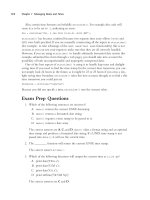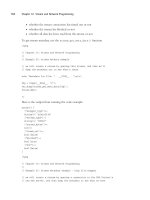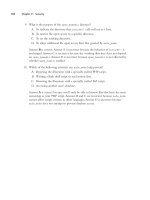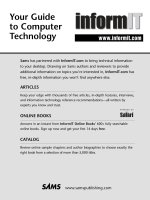Zend PHP Certification Study Guide- P12
Bạn đang xem bản rút gọn của tài liệu. Xem và tải ngay bản đầy đủ của tài liệu tại đây (216.04 KB, 20 trang )
204
Chapter 13 Getting Ready for the Certification Exam
Zend may, at its sole discretion, designate a logo for limited use by those individuals
who have passed this exam (the “Logo”).The Logo is personal and may only be used
by you and no other person or entity.You may use the Logo only on your personal
business cards, letterhead, personal website, and your resume and not in any other
form.You are prohibited from displaying or using the Logo in any way that may
imply that you are an employee or otherwise related to, or endorsed by, Zend.The
Logo only relates to that level of certification that you have achieved.You may not
modify or otherwise alter or change the Logo. In the event your certification expires
or is otherwise terminated, you will immediately cease use of the Logo.
Viewing Backward and Forward
During the exam, the examinee may page back and forward at any time. Even after the
completion of the entire exam, you may go back to review, change, and edit answers.
Once the End Exam button has been pressed, the exam is processed and no changes can
be made.
Reviewing Your Answers
If you are unsure about a certain question during the test or would like to remind your-
self to come back to a question at the end of the test, you may use the Review feature.
This is a recommended and time-saving feature. It appears as a review check box on the
upper left-hand corner of the exam delivery application. Checking this box will mark
the question for review, and at the end of the exam, a summary of all the questions
marked by you will be displayed with the option to go back and iterate through only
those questions.
Your Comments
Examinees are able to leave comments throughout the duration of the exam by either
clicking the comment button at the bottom of the screen or pressing ALT+M, which
opens a comment window. It is suggested that you only leave comments after you have
completed all the questions. No extra time will be added to the exam for the time taken
to write comments.
What Kinds of Questions Are Asked?
The certification test consists of four different question types: single choice, multiple
choice, fill in the blanks, and open questions.
Single Choice Questions
A single choice question begins with a question or comment and is sometimes accom-
panied with some PHP code or code output.The examinee is requested to choose a
14 7090 ch13 7/16/04 8:43 AM Page 204
Please purchase PDF Split-Merge on www.verypdf.com to remove this watermark.
205
What Kinds of Questions Are Asked?
single answer from a given selection of between two and six answers. There is only one
correct answer for these types of questions and only one answer can be marked.You will
normally notice answers that might seem correct but because of some small detail, they
are not. Pay attention to exactly what is being asked!
An example of a single choice question is
What does PHP stand for?
A. People Helping People
B. PHP Hypertext Preprocessor
C. PHP Hypertext Preprocessing
D. Perl Hypertext Preprocessor
Figure 13.1 shows an example of how a single choice question would appear in an
exam.
Figure 13.1 A single choice question.
Multiple Choice Questions
Constructed similar to single choice questions though with one major difference; the
multiple choice questions have between two and four correct answers.The examinee is
notified of the number of correct answers that should be checked.This tip might not
exist in future versions on the PHP certification—in which case, it will be up to the
examinee to decide how many answers he thinks are correct and should be marked.
14 7090 ch13 7/16/04 8:43 AM Page 205
Please purchase PDF Split-Merge on www.verypdf.com to remove this watermark.
206
Chapter 13 Getting Ready for the Certification Exam
An example of a multiple choice question is
Which of the following are directives in the
php.ini
file? (Choose three.)
A.
session.save_handler
B.
asp_tags
C.
output_buffering
D.
flush
Figure 13.2 shows an example of how a multiple choice question would appear in an
exam.
Figure 13.2 A multiple choice question.
Fill in the Blanks Questions
The examinee is provided with one or more sentences that have had parts extracted and
replaced with underscores.The examinee then chooses the most appropriate set of
extractions that, when placed back in to the sentence, make it correct.There is only one
correct answer for this type of question.
14 7090 ch13 7/16/04 8:43 AM Page 206
Please purchase PDF Split-Merge on www.verypdf.com to remove this watermark.
207
What Kinds of Questions Are Asked?
An example fill in the blank question is
PHP is a general purpose ___________ language that is mostly used for
___________ and can be embedded in ___________.
A. Web,Web development, web pages
B. scripting,Web development, HTML
C. scripting, server-side development, JavaScript
D. procedural,Web development, HTML
Open Questions
An open question is probably the most difficult question type where the examinee is
requested to give text answers to the question. There are no choices here but just a text
box for the answer.The majority of these questions will request a PHP function name
(do not include the parentheses in the answer), where others might request the output of
a code snippet or other PHP keywords.
An example open question is
What function in PHP is used to display an HTML output of the PHP configura-
tion and setup?
Answer: __________________
Figure 13.3 shows an example of how an open question would appear in an exam.
Figure 13.3 An open question.
14 7090 ch13 7/16/04 8:43 AM Page 207
Please purchase PDF Split-Merge on www.verypdf.com to remove this watermark.
14 7090 ch13 7/16/04 8:43 AM Page 208
Please purchase PDF Split-Merge on www.verypdf.com to remove this watermark.
Practice Exam Questions
1. Which of the following strings are not valid modes for the
fopen()
function?
A.
a+b
B.
b+a
C.
at
D.
w
E.
x+
2. Consider the following piece of code:
<?php
$arr = array(3 => “First”, 2=>“Second“, 1=>“Third“);
list (, $result) = $arr;
?>
After running it, the value of
$result
would be
A.
First
B.
Second
C.
Third
D. This piece of code will not run, but fail with a parse error.
3. In standard SQL-92, which of these situations do not require or cannot be handled
through the use of an aggregate SQL function? (Choose 2)
A. Calculating the sum of all the values in a column.
B. Determining the minimum value in a result set.
C. Grouping the results of a query by one or more fields.
D. Calculating the sum of all values in a column and retrieving all the values of
another column that is not part of an aggregate function or
GROUP BY
clause.
E. Determining the mean average of a column in a group of rows.
4. Multidimensional arrays can be sorted using the ______ function.
15 7090 Practice Exam 7/16/04 8:42 AM Page 209
Please purchase PDF Split-Merge on www.verypdf.com to remove this watermark.
210
Practice Exam Questions
5. When using the default session handler
files
for using sessions, PHP stores
session information on the harddrive of the webserver.When are those session
files cleaned up?
A. PHP will delete the associated session file when
session_destroy()
is
called from within a script.
B. When the function
session_cleanup()
is called, PHP will iterate over all
session files, and delete them if they exceeded the session timeout limit.
C. When the function
session_start()
is called, PHP will iterate over all
session files, and delete them if they exceeded the session timeout limit.
D. When the function
session_start()
is called, PHP will sometimes iterate
over all session files, and delete them if they exceeded the session timeout
limit.
E. Session files are never removed from the filesystem, you need to use an auto-
mated script (such as a
cronjob
) to do this.
6. What is the order of parameters in the
mail()
function?
A. subject, to address, extra headers, body
B. to address, subject, extra headers, body
C. to address, subject, body, extra headers
D. subject, to address, body, extra headers
7. Which of the following statements are correct? (Choose 3)
A.
sprintf()
does not output the generated string.
B.
printf(
“
%2s%1s
“
,
“
ab
“
,
“
c
“
)
outputs the string
abc
.
C.
vprintf()
takes at least one parameter; the first parameter is the formatting
string and the following parameters are the arguments for the ‘
%
’
placeholders.
D.
printf(
“
%c
“
,
“
64
“
)
will output
@
and not
6
.
E.
sprintf(
“
%3.4f
“
, $x)
outputs more than 7 characters.
F.
number_format()
inserts thousands of separators and decimal points differ-
ent from (
,
) and (
.
) respectively, while
printf()
like functions always use
(
.
) as decimal point.
15 7090 Practice Exam 7/16/04 8:42 AM Page 210
Please purchase PDF Split-Merge on www.verypdf.com to remove this watermark.
211
Practice Exam Questions
8. The requirement is to return
true
for the case in which a string
$str
contains
another string
$substr
after the first character of
$str
? Which of the following
will return
true
when string
$str
contains string
$substr
, but only after the first
character of
$str
?
I.
<?php
function test($str, $substr) {
return strpos(substr($str,1), $substr) >= 0;
\}
?>
II.
<?php
function test($str, $substr) {
return strrchr($str, $substr) !== false;
\}
?>
III.
<?php
function test($str, $substr) {
return strpos($str, $substr) > 0;
\}
?>
A. I only
B. II only
C. III only
D. I and II
E. I and III
F. II and III
9. Which of the features listed below do not exist in PHP4? (Choose 2)
A. Exceptions
B. Preprocessor instructions
C. Control structures
D. Classes and objects
E. Constants
15 7090 Practice Exam 7/16/04 8:42 AM Page 211
Please purchase PDF Split-Merge on www.verypdf.com to remove this watermark.









